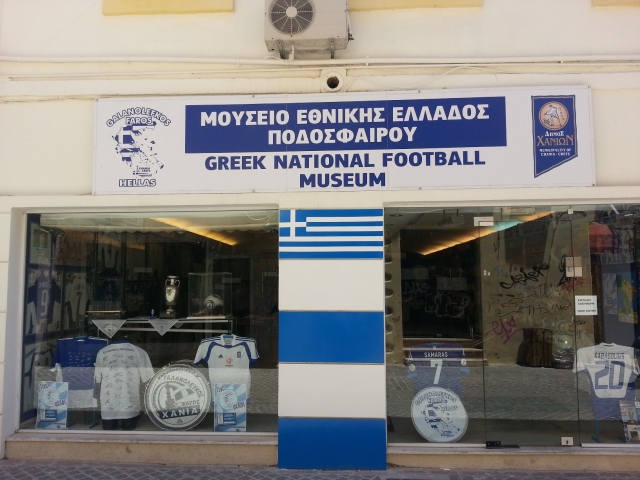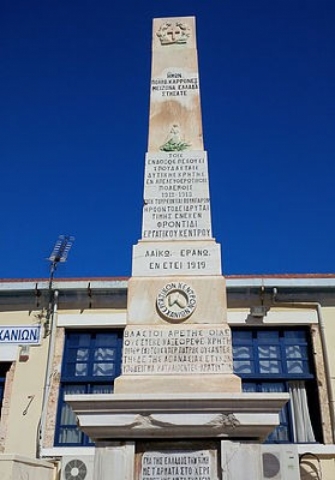Νομός: Χανίων

Μέρη κοντινά με Άγιος Ιωάννης
Η Δημοτική Αγορά Χανίων, συνολικού εμβαδού 4.000 τ.μ., βρίσκεται στο κέντρο των Χανίων, στο σημείο που σήμερα χτυπά η καρδιά της πόλης. Η θεμελίωση της ξεκίνησε στις 14 Αυγούστου 1911, στο σημείο όπου στεκόταν επί Ενετοκρατίας ο κύριος προμαχώνας των οχυρώσεων ενώ η κατασκευή του κτιρίου ολοκληρώθηκε το δεύτερο εξάμηνο του 1913.
Τα επίσημα εγκαίνιά για τη λειτουργία της Δημοτικής Αγοράς έγιναν από τον τότε πρωθυπουργό της Ελλάδας Ελ. Βενιζέλο στις 4 Δεκεμβρίου 1913, τρείς μέρες μετά την επίσημη τελετή της Ένωσης της Κρήτης με την Ελλάδα. Η Δημοτική Αγορά έχει σχήμα σταυρού και τέσσερις πόρτες, μία σε κάθε πτέρυγα, που κλείνουν για να παρέχουν ασφάλεια στα καταστήματα που στεγάζονται εκεί. Σήμερα στο κτίριο της Αγοράς στεγάζονται πολυάριθμα καταστήματα που πωλούν τοπικά προϊόντα άλλα και αναμνηστικά είδη. Η Δημοτική Αγορά αποτελεί αρχιτεκτονικό στολίδι για τα Χανιά και είναι μία από τις εντυπωσιακότερες στο βαλκανικό χώρο.
Σημαντικό ειδικό κτίριο της εποχής της Κρητικής Πολιτείας. Είναι κτισμένο σε σχήμα ελευθέρου σταυρού, επηρεασμένο από τα κτίρια της λεγομένης "εποχής του σιδήρου" του τέλους του 19ου αι. που χαρακτηρίζει την βιομηχανική επανάσταση. Στο κτίριο, που διακρίνεται για την κομψότητα και την ισορροπία του, διατηρούνται, σχηματοποιημένα τα μορφολογικά στοιχεία του ύστερου νεοκλασσικισμού.
Στις 14 Απριλίου 1911 η Αγορά θεμελιώθηκε από τον Δήμαρχο Μανώλη Μουντάκη και στις 4 Δεκεμβρίου 1913 εγκαινιάζεται από τον Πρωθυπουργό Ελευθέριο Βενιζέλο στα πλαίσια του εορτασμού της Ένωσης της Κρήτης με την Ελλάδα. Έκτοτε λειτουργεί αδιάκοπα ως αγορά Χανίων.
Chania, also transliterated as Hania, is the second largest city of Crete and the capital of the Chania Prefecture. It lies along the north coast of the island, about 70 km west of Rethymno and 145 km west of Heraklion. The official population of the municipal area is 53,373 but some 70,000 people live in the greater area of Chania. Most of the visitors believe that Chania is Greece`s most beautiful city... Chania is a unique city bearing a rich and long history and culture. Its name is often glorified in historical documents as the city raised brave soldiers, groundbreaking politicians, intellectuals and artists. It is considered the city of Justice and Freedom and its rare beauty justifies its characterization as the "Venice of the East". The city of Chania was a crossroad between the East and the West for many centuries, and for this reason it was claimed by its enemies and suffered the presence of many conquerors. Always the first thing you hear about Chania - the Venetian Harbour, the old port, the narrow shopping streets and waterfront restaurants. Chania is also one of the places you are most likely to see on arriving in Crete. It is beautiful - that is to say much of the Chania you will want to see is clustered close to the harbour - old buildings, museums, churches and crafts shops (some with genuinely interesting and sometimes local, products on offer). Food is offered in great variety and sometimes great similarity - there are many restaurants and also cafes, at which to reflect upon the experiences of places you have just explored together with the enjoyment of some tasty food - we have suggestions for restaurants further on. The atmosphere has a touch of Florence and Venice (a few years ago when those cities still had some room to walk), combined with the culture and character of Cretan people and traditions. The Chania harbour is wonderful and at any particular time of day the light produces a different result, creating a "different place". This is the best chance to see some of the old buildings - of Venetian and Turkish design, that Crete once had across the island - many have since been destroyed by the ravages of war and plunder. Chania is surrounded by numerous rich options for sightseeing, exploration and discovery. Mountain villages provide a view into the "inner Crete". The Samaria and many other gorges can be hiked, archaeological sites abound. What to see at the city Explore the waterfront and streets just behind. Walk along the harbour wall to the Venetian Lighthouse. Visit the wonderful Naval Museum (Maritime Museum) - it delivers a superb introduction to the History of Crete and is by no means only for maritime mavens, you will learn more here in half an hour than most could teach you, about the events that filled Crete's moving past. Excellent, well done. Open: 10.00 to 14.00 daily, except Monday. Tel: 28210-91875. Admission: 2.50 euros. The Archaeological Museum on Halidon Street is smaller than its grand Heraklion cousin, though well worth visiting and appealing even to non archaeologists. Open: 8.00 to 17.00 (to 19.30 April-October) daily, except Monday. Tel: 28210-90334. Admission: 1.5 euros Historical Archives (museum): Open 9.00 to 13.00, Monday to Friday. Tel: 28210-52606. Admission: Free. Byzantine Museum. Open: 8.30 to 14.00 daily, except Monday. Tel: 28210-96046. Near the waterfront (at the back of the Naval museum). Outside Chania; trips to the many surrounding monasteries, the Samaria Gorge (take a bus to Omalos or a tour as you will walk the Gorge, take a ferry from the end at Agia Roumeli to Sfakia and then a bus back to Chania), Venizelos Graves and visit nearby villages where the old men talk, argue, discuss, play cards at their local kafeneio or simply find a stretch of beach and immerse the cares of yesterday in the waters of today. With children you might treat them with a visit to the water park at Limnoupolis. Rethymno, Crete's other Venetian town is an hour away by car or bus. The Therissos gorge, Kolymbari and its monastery, the wide sweep of Falassarna beach, boat trips to Gramvousa & Balos, a longer and most scenic trip to Elafonissi and villages en route - the list is long enough to fill many days. (all information can be changed without prior notice) Historical facts about Chania The Historical Years During the so called Historical Years, Kythonia seems to have been a powerful city-state, whose domain extended from Hania Bay to the feet of the White Mountains. Kythonia was constantly at war with other city-states such as Aptera, Falasarna nad Polyrrinia. In 69 B.C. the Roman Consul Cointus Metellus defeated the Cretans and conquered Kythonia to which he granted the privileges of an independent city-state. Kythonia reserved the right to mint its own coins until the 3rd century A.D. The Roman conquest put an end to the civil wars and a period of peace began, unique in the history of the island. The Kythonia of the Historical Years was of the same size as the city of Hania at the beginning of the 20th century. First Byzantine Period Information about the Kythonia of the Christian Years is limited. The most important archeological finds are those of the remains of a Basilica, discovered recently near the Venician Cathedral in the centre of Kasteli. Various sources mention the Kythonia Diocese and the Bishop Kythonios, who participated in the Sardinian Synod in 343. Kythonia is mentiond among the 22 most important cities of Crete in the "Document of Ieroklis" in the 6th Century. The Kytonia Diocese is also mentioned in all the "Ecclesiastical Minutes" (taktica), before and after the Arabian Occupation. The Arabian Occupation The occupation of Crete by the Arabs was effected gradually from 821 to 824. The consequences of the arrival of the Arabs in Crete were rather painful for the local population, who were subjected to a long and horrible period of slavery, resulting in the alienation of Crete from the Byzantine empire. St. Nicholas Stouthitis was born in 763 in Kythonia, which he left at the age of 10 to go to Constantinople. In 961, Nikiforos Fokas managed to free Crete and bring it back under the control of the Byzantine empire. The Byzantine Period The first action of the Byzantine empire, after reconquering Crete, was to re-establish their authority and power. Not only should all traces of the Arab occupation be abolished but also the defense of the island had to be organised quickly in order to avoid any Arab attempt to take back the island. Thus, strong fortifications are constructed along the coast and at strategic positions. The hill of Kasteli is fortified with a wall along its perimeter. This was constructed with building materials taken from the ancient city. It is still regarded as a remarkable military accomplishment and a proof of the continuous existence of the city in the period between the Arab and the Venician occupations. The Venician Occupation After the 4th Crusade and the dismantling of the Byzantine empire, in 1204, Crete is given to Bonifacio, the Marquis de Monfera. He, in turn, chooses to sell it to the Venicians for 100 silver marks. In 1252 the Venicians manage to subdue the locals as well as the Genoans, who, under the leadership of the Count of Malta Henrico Pescatore, had seized Crete. Hania is chosen as the seat of the Rector (Administrator General) of the region and flourishes as a significant commercial centre due to the fertility of the land. Contact with Venice leads to the social, economic and cultural conditions necessary for the growth of a culture strongly affected both by the Venician and the local element. The Turkish Occupation The Turks land near the Monastery of "Gonia" (Corner) in Kissamos, which they plunder and burn. They seize the fortified isle of "Agioi Theodori" and, after a two month siege, the City of Hania on 2nd August 1645. A new state of affairs prevails in the city, where churches are turned into mosques and Christian fortunes come to the hands of the conquerors. The Turks reside mostly in the eastern districts, Kasteli and Splanzia, where they convert the church of St Nicholas of the Dominicans into their central mosque "Houghiar Tzamissi" (The Sovereign's Mosque). Besides turning catholic churches into mosques, they build new ones such as "Kioutsouk Hassan Tzamissi" on the harbour. They also build public baths (Hamam) and fountains. In 1821 many Christians are slaughtered and the Bishop of Kissamos, Melhisethek Thespotakis is hanged in Splantzia. In 1878, the Treaty of Halepa is signed and the Christians are granted certain rights. In 1898, the semi-autonomous "Cretan State" is established and the city of Hania flourishes as the Capital of Crete.
Ανατολικά της πλατείας της Σπλάτζιας στην παλιά πόλη των Χανίων, βρίσκεται η εκκλησία του Αγίου Νικολάου, η οποία κτίστηκε λίγο πριν το 1320, επί Ενετών, ως μοναστήρι του τάγματος των Δομινικανών μοναχών. Στην Βενετοκρατία αποτελούσε την πιο σημαντική εκκλησία της πόλης.
Ήταν κομψή και μεγάλη σε χωρητικότητα, με πλατιές καμάρες στο εσωτερικό. Μετά την επικράτηση των Τούρκων στα Χανιά ο ναός μετατράπηκε σε τέμενος και ονομάστηκε Χιουγκάρ Τζαμισί (το τζαμί του Ηγεμόνα-Αυτοκράτορα), προς τιμήν του σουλτάνου της Οθωμανικής Αυτοκρατορίας, Ιμπραήμ.
Το τζαμί απέκτησε εντυπωσιακό μιναρέ, ο οποίος ξεχωρίζει από τους υπόλοιπους της πόλης, καθώς διαθέτει δύο εξώστες. Το 1928, αφού το κατέλαβαν χριστιανοί ορθόδοξοι, το τέμενος μετατράπηκε σε χριστιανική εκκλησία και αφιερώθηκε στον Άγιο Νικόλαο.
ΔΙΚΑΣΤΙΚΟ ΓΡΑΦΕΙΟ ΧΑΝΙΩΝ (ΤΡΑΠΕΖΑ ΝΟΜΙΚΩΝ ΠΛΗΡΟΦΟΡΙΩΝ )
Ανδρέα Παπανδρέου 65 ΤΚ731 00
Τηλέφωνο:28213 45700, 28210 27620, 28210 50522 28210 50522,
Φαξ: 28210 27620
Στην πλατεία της Σπλάντζιας βρίσκεται η εκκλησία του Αγίου Νικολάου, η οποία κτίστηκε λίγο πριν το 1320, επί Ενετών, ως μοναστήρι του τάγματος των Δομινικανών μοναχών. Μετά την επικράτηση των Τούρκων στα Χανιά το 1645, ο ναός μετατράπηκε σε τέμενος και ονομάστηκε Χιουγκάρ Τζαμισί (το τζαμί του Ηγεμόνα-Αυτοκράτορα), προς τιμήν του σουλτάνου της Οθωμανικής Αυτοκρατορίας, Ιμπραήμ.
Εδώ φυλασσόταν και το ξίφος του τούρκου Δερβίση, που ήταν ο πρώτος που μπήκε μέσα στην πόλη και θεωρούνταν ιερό και θαυματουργό. Το τζαμί απέκτησε εντυπωσιακό μιναρέ, ο οποίος ξεχωρίζει από τους υπόλοιπους της πόλης, καθώς διαθέτει δύο εξώστες. Τα μορφολογικά στοιχεία του μιναρέ, που πρόσφατα αναστηλώθηκε, ακολουθούν τη βενετσιάνικη παράδοση.
Κάτω από την πλατεία βρέθηκαν με ανασκαφές ένα τούρκικο λουτρό και μια Ενετική δεξαμενή νερού, τέτοιας χωρητικότητας ώστε να καλύπτει την πόλη των Χανίων για έξι μήνες. Η δεξαμενή αχρηστεύτηκε μετά από τους σεισμούς του 1595 που άλλαξαν την ροή του ποταμιού που την τροφοδοτούσε.
Πιθανότατα η εκκλησία του San Rocco να ήταν χτισμένη σε αυτό το σημείο όπου βρίσκεται η πλατεία 1821. Στην πλατεία υπάρχει μια πλάκα στη μνήμη στου Επισκόπου Μελχισεδέκ, τον οποίο οι Τούρκοι κρέμασαν σ´ ένα πλάτανο το 1821 επειδή φοβόντουσαν κάποια πιθανή εξέγερση.
Στη βόρειο-ανατολική πλευρά του Δημοτικού Κήπου βρίσκεται το εντυπωσιακό Ρολόι της πόλης, το οποίο άρχισε να χτίζεται το 1924 και τέλειωσε το 1927 και το οποίο αποτελεί ένα από τα πιο αξιοσημείωτα κτίσματα της πόλης των Χανίων.
Μιναρές του Αχμέτ Αγά
Τα Μουσουλμανικά τεμένη συμπληρώνουν την θρησκευτική ζωή των μωαμεθανών Τούρκων στην Κρήτη. Στην οδό Χατζημιχάλη Νταλιάνη (πρώην Σχοινοπλοκάδικα) βρίσκεται το Αγά Τζαμί στα Χανιά, από το οποίο σώζεται σήμερα ο μιναρές και μερικά από τα κτίρια στα οποία στεγάζεται βιοτεχνία πλεκτηρίου.
Along the famous waterfront there are built numerous cafes, bars and a few traditional tavernas with wonderful views to the sea and a part of the Venetian Walls. The locals usually prefer this part of the waterfront to have a coffee in the evening or a first drink during the night.
The history of Kum Kapi starts during the last years of the Turkish occupation when the Arabs grew "Halikoutes", a small village, near a sandy beach and next to the Venetian fortifications. This district was called in Turkish "Kum Kapisi" (meaning Gate of the Sand) because of the Venetian Gate built there.
If you want to have a coffee in the Kum Kapi waterfront you can try the following cafe-bars; Elliniko at the start, Thema at the centre, Il Nostro at the end, and the rock-cafe Other Side near the end. There are also many choices for food like the first two restaurants at the start of the waterfront (O Aswtos Yios, Diachroniko) or the restaurant next to the Thema.
The area of Kum Kapi is quite near the old Venetian Town so that you can walk to get from the one place to the other. While walking , if you follow the seafront, you will meet more seafood restaurants (try the Dinos Restaurant) and cafes (try the Dio Lux).
Προμαχώνας Santa Lucia
Ο προμαχώνας Santa Lucia βρίσκεται στην νοτιοανατολική γωνιά των ενετικών οχυρώσεων, και πήρε το όνομα του από την ορθόδοξη εκκλησία της Αγίας Φωτεινής (Lucia), που βρισκόταν στη σημερινή οδό Μίνωος.
Το 1568 κατασκευάστηκε ο επιπρομαχώνας της Santa Lucia, του οποίου ένα μέρος σώζεται στην οδό Μίνωος. Μεγάλο τμήμα του προμαχώνα έχει καταχωθεί στη δεκαετία του 1930 κάτω από την οδό Νικηφόρου Φωκά & Κύπρου.
Το Μουσείο της Εθνικής Ελλάδος αποτελεί ένα μοναδικό στο είδος του μουσείο στην Ελλάδα και ένα από τα ελάχιστα που υπάρχουν σε επίπεδο εθνικών ομάδων παγκοσμίως.
Μέσα σε αυτό «ζωντανεύει» η ιστορία της Εθνικής Ελλάδος ποδοσφαίρου την οποία ο επισκέπτης μπορεί να γνωρίσει μέσα από τα εκατοντάδες αντικείμενα και φανέλες της Εθνικής ομάδας τόσο του σήμερα, όσο και από παλαιότερες εποχές. Από τα πιο δημοφιλή αντικείμενα που μπορεί να δει κάποιος στο Μουσείο είναι οι φανέλες των Ελλήνων διεθνών από ιστορικά παιχνίδια και όχι μόνο, το αντίγραφο του Κυπέλλου από την κατάκτηση του Ευρωπαϊκού Πρωταθλήματος του 2004, το εισιτήριο του τελικού Ελλάδα-Πορτογαλία, η μπάλα από το παιχνίδι Ελλάδα-Νιγηρία 2-1, την μοναδική νίκη της Εθνικής σε Μουντιάλ και άλλα πολλά…
The War Museum of Athens founded a department in 1995, in the framework of a cooperative program between the two cities and museums.
The aim of the Museum is the collection, protection, conservation and exhibition of war artifacts and other items, mainly from the period 1821-1940 that covers most of the national wars and revolutions, including the participation of Cretan soldiers in the Macedonian Wars (1903 - 1922) in the Balkan Wars (1912-13), the Asia Minor Campaign (1919-1922), in the World Wars I and II and during the German occupation (1941-1945).
Tel: (2821) 0 44156
Έξοχο παράδειγμα νεοκλασσικής αρχιτεκτονικής όπως αυτή εφαρμόστηκε τις τελευταίες δεκαετίες της τουρκοκρατίας. Κατασκευάστηκε στο προάστειο της Χαλέπας και είναι από τα σημαντικότερα κτίσματα των Χανίων.
Κτισμένο στον τύπο της βίλας, το κτίριο διακρίνεται για την κομψότητα, την ισορροπία των όγκων του και την λιτότητα των μορφών του. Ιδιαίτερο ενδιαφέρον παρουσιάζουν η διαμόρφωση της κύριας εισόδου, που ανοίγεται στην αυλή, με την μαρμάρινη σκάλα και το προστώο, καθώς και ο εσωτερικός διάκοσμος του κτίσματος.
Κτίστηκε γύρω στο 1860. Από το 1865 υπήρξε το επίκεντρο κάθε κοινωνικής και φιλανθρωπικής κίνησης στην Κρήτη, στα τελευταία χρόνια της Τουρκοκρατίας και εκείνα της Αρμοστίας στο νησί. Έχει κηρυχθεί διατηρητέο μνημείο.
Υπόγεια κρήνη, η κατασκευή της οποίας φαίνεται ότι έγινε κατά τον 18ο αιώνα και η διαμόρφωση του χώρου αντίστοιχα στα τέλη του 19ου αιώνα.
Είκοσι έξι πέτρινα σκαλοπάτια οδηγούν στην αίθουσα της κρήνης, η οποία και είναι χωρισμένη σε τρεις στενόμακρες αίθουσες από τοξοστοιχίες των δύο τόξων. Ο δυτικός τοίχος είναι χτισμένος από επιμελημένη λαξευτή τοιχοποιία με γείσα και ανάγλυφα οξυκόρυφα τόξα στα σημεία όπου είναι οι μαρμάρινοι κρουνοί. Πίσω από το λαξευτό τοίχο υπάρχει ισοπλατής θολοσκέπαστη δεξαμενή, που έχει ορθογώνιο άνοιγμα για την υπερχείλιση του νερού, αλλά και για τον καθαρισμό της.
Το μαρμάρινο μνημείο, με τη μορφή Αναθηματικής Στήλης, που όλοι βλέπουμε στην αυλή του 1ου Γυμνασίου, φιλοτεχνήθηκε στο μαρμαρογλυφείο Νικητάκη και στήθηκε για να τιμηθούν οι τελειόφοιτοι μαθητές και φοιτητές, πρώην μαθητές του Γυμνασίου Χανίων, που έδωσαν τη ζωή τους για την απελευθέρωση της Μακεδονίας και της Ηπείρου.










